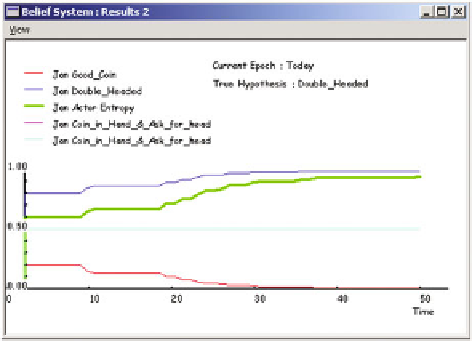Information Technology Reference
In-Depth Information
Fig. 6.3
Agent 'Jan' starts
with a positive bias
Agent 'Jan' in Fig.
6.2
believes 0.2 that the coin is good and 0.8 that it is double
headed. The result is a steady increase in confidence towards the final conclusion
that it is a 'fact'.
The flat centre plotlines in these figures indicate that in all cases the actions
'Ask for head' and 'Ask for tail' remain equally likely (probability of 0.5). From an
information point of view the options are about the same, no matter what the agent's
belief might be. This is due to the simplicity of the situation. In more complex cases
a genuine bias between the actions will become apparent as belief changes (see
Gooding and Addis
2004
) (Fig.
6.3
).
6.11
Other Examples
We have also run this simulation using an extension of Wason's four-card problem
(Wason
1960
; Wason and Shapiro
1971
). In the original task sets of four cards are
displayed, two showing integers and two characters (e.g., A, D, 4, 7). The subject
is asked to turn a card (or cards) to show that the rule 'An even number implies
a vowel on the other side'. Wason was testing whether subjects reasoned so as to
falsify the rule (so the expected action is to turn an even number and just one other
card (Johnson-Laird and Wason
1977
)). We adapt this problem by providing our
agents with 100 cards and, in some scenarios, access to other agents. Each card
represents a possible experiment, although there are only four distinct choices (to
turn a vowel, a consonant, an odd or an even). The entropy-driven mixed strategy (see
Evaluation Actions—Choosing Actions) implies that the rule should be discovered
with a minimum number of turns.
This scenario allows for ten possible logically distinct rules (or hypotheses; see
Addis and Gooding
1999
, pp. 23-24). The simulated agents 'home in' on the correct
rule within ten or so moves (see Fig.
6.4
). They also correctly eliminate the redundant

